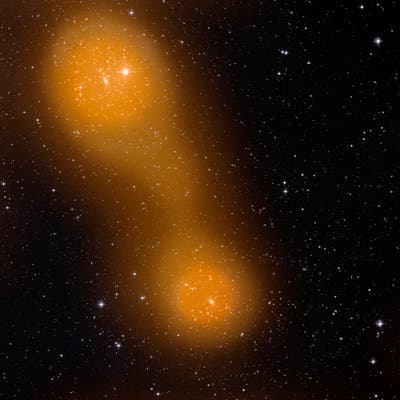
Astronomers have for the first time confirmed a bridge of hot gas with a temperature of about 80 million degrees Kelvin connecting a pair of galaxy clusters 10 million light-years apart. The discovery is of particular importance since it might help shed light on the missing baryonic matter that has been puzzling scientists for decades.
The two galaxy clusters, Abell 399 and Abell 401, each contain hundreds of galaxies and are several billion light years away from Earth. In the early universe, filaments of gaseous matter pervaded the cosmos in a giant web, with clusters eventually forming in the densest nodes, according to the leading theory on the matter – this is called the warm-hot intergalactic medium (WHIM).
Despite the fact that we’ve yet to see any actual evidence or manage to pinpoint what exactly these are, the Universe is dominated by what’s ambiguously called dark matter and dark energy. What we can actually measure and see – stars, galaxies, cosmic clouds of dust and gas, and so on – only make up a tiny fraction of the Universe, less than 5%. This ‘white’ matter is commonly referred to among astronomers as baryonic matter.
Now, this baryonic matter can be generally detected by measuring the electromagnetic radiation it releases. When observing distant cosmic objects like far away galaxies and stars, however, the baryonic matter readings do not match those from nearby – there’s a mismatch between matter in the ancient Universe and the close Universe. About half of the baryonic matter expected to be present in the local Universe is missing. So where is it?
Well, many scientists believe it lies in this warm-hot intergalactic medium or WHIM that I mentioned earlier. Cosmic simulations have revealed that both dark and baryonic matter are embedded in a filamentary network, and that the WHIM might account for most of the baryonic matter in the local Universe. This network of tenuous gas ranges in temperature from 100,000 to several tens of millions of K and due to its extremely low density has proved very hard to detect.
Hot gas bridging galaxy clusters
This latest findings based on microwave and sub-millimetre wavelength observation using ESA’s Planck satellite has brought new light into these theories.
“Although the WHIM is mainly organised in long and diffuse filaments, we expect to find it also in the proximity to galaxy clusters, which are the largest gravitationally-bound structures in the Universe,” explains José M. Diego, a Planck Collaboration scientist from the Instituto de Fisica de Cantabria (UC-CSIC) in Santander, Spain.
“Planck can detect galaxy clusters across the sky because the hot gas that fills them imprints a characteristic signature on the Cosmic Microwave Background known as the Sunyaev-Zel’dovich effect,” Diego adds. “Based on the same principle, Planck could be sensitive to gas from the WHIM, too”.
In other words, this Sunyaev-Zel’dovich or S-Z effect describes a phenomenon in which cosmic microwave background light interacts with the hot gas permeating these huge cosmic structures, which leads to energy distribution being modified in a characteristic manner.
“Detecting the WHIM via the Sunyaev-Zel’dovich effect is extremely challenging due to its low density,” comments Juan Macias-Perez, a Planck Collaboration scientist from the Laboratoire de Physique Subatomique et de Cosmologie in Grenoble, France. “The best chance to detect it is to look at the regions between pairs of nearby galaxy clusters that are interacting with one another: as they approach each other, gas in the inter-cluster region becomes denser and hotter, hence easier for us to spot,” he adds.
So the scientists looked at data collected by the Planck surveys, and looked for clusters that satisfy a somewhat delicate condition – close enough for intervening filaments to be detected, but also separate enough for Planck to be able to resolve as individual sources. Picky, picky, but they hit the jackpot eventually.
“A careful analysis revealed a ‘bridge’ of hot gas connecting two of the clusters in the sample: Abell 399 and Abell 401,” comments Diego.
By combining Planck data with archival X-ray observations from the German satellite Rosat, the astronomers found that the temperature of the gad bridge between the two galaxy clusters was roughly 80 million degrees Kelvin.
Early analysis suggests that it could be a mixture of the elusive filaments of the cosmic web mixed with gas originating from the clusters, but more data is needed for a through conclusion to be made. Next, the scientists are keen on studying another promising galaxy cluster pair – the composite system Abell 3391-Abell 3395, which is highly substructured and may in fact consist of three or four clusters.
“This discovery highlights the ability of Planck to probe galaxy clusters out to their outskirts and even beyond, allowing us to investigate the connection between intra-cluster gas and gas that is part of the cosmic web,” concludes Jan Tauber, Planck project scientist at ESA.
Findings were published in the journal Astronomy & Astrophysics.
source: ESA






